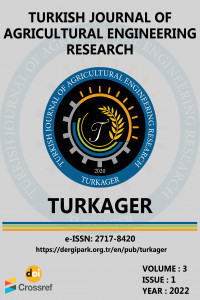Investigation of Some Physical Properties of Two Varieties of Sweet Potato (Ipomoea batatas (L.) Lam)
Investigation of Some Physical Properties of Two Varieties of Sweet Potato (Ipomoea batatas (L.) Lam)
Investigation, Parameters Physical properties, Sweet potato, Varieties,
___
- Akaaimo DI and Raji OA (2006). Some physical engineering properties of prosopsis Africana seed. Biosystems Engineering, 95(2): 197-205.
- Anazado UGN (1983). Force deformation analysis for biomaterials in radial compression: Maximum Contact Stress: apricot pit and its kernel. Journal of Food Engineering, 56: 49-57.
- Aviara NA, Gwandzang MI and Haque MA (1999). Physical properties of guna seeds. Journal of Agricultural Research, 73: 105-111.
- Balami AA, Mohammed IA, Adebayo SE, Adgidzi D and Adelemi AA (2012). The relevance of some engineering properties of cocoyam (Colocasia esculenta) in the design of postharvest processing machinery. Academic Research International, 2(3): 104-113.
- Bart-Plange A and Baryeh EA (2003). The physical properties of category B cocoa beans. Journal of Food Engineering, 60: 219-227.
- Baryeh EA (2000). Strength properties of avocado pear. Journal of Agricultural Engineering Research, 76(4): 389-397.
- Baryeh EA (2001). Physical properties of Bambara groundnuts. Journal of Food Engineering, 47(4): 321-326.
- Burum S (2004). American cinematographer manual (9th ed). ASC Press. ISBN 0-935578-24-2.
- Desphande SD, Bal KN and Ojha TP (1993). Physical properties of soybean. Journal of Agricultural Engineering Research, 56: 89-98.
- Isik E I and Unal H (2007). Moisture dependent physical properties of white speckled red kidney bean grains. Journal of Food Engineering, 82: 209-206
- IBM SPSS (2012). IBM Corp. Released 2012. IBM SPSS Statistics for Windows, Version 21.0. Armonk, NY: IBM Corp.
- Joshi DC, Das SK and Mukherjiee RK (1993). Physical properties of pumpkin seeds. Journal of Agricultural Engineering Research, 54(3): 222- 229.
- Kachru RP, Gupta RK and Alan A (1994). Physio-chemical constituents and engineering properties of food crops. Scientific Publishers, Jodhpur, India.
- Kashaninejad MLG, Tabil AM and Kordi AS (2003). Effect of drying methods on the quality of pistachio nuts. Drying Technology 21(5): 821-838.
- McClue JE and Morrow CT (1987). Computer vision sorting of potatoes. ASAE Paper, No 87-6501.
- Mohsenin NN (2010). Physical properties of plant and animal materials, structure, physical characteristics and mechanical properties. 2nd edition (Revised); Gordon & Breach Science Publishers, New York.
- Naskar SK, Nedunchezhiyan M and Rao KR (2008). Evaluation of sweet potato cultivars for quality traits. In: New R and D Initiative in Horticulture for Accelerated Growth and Prosperity. 3rd Indian Horticultural Congress. Bhubaneswar, p: 340, Orissa, India.
- Oke MO, Awonorin SO, Sanni LO, Akanbi CT and Abioye AO (2007). Determination of some selected engineering properties of sweet potato cuts as a function of temperature. Journal of Food Technology, 5(1): 66-70.
- Olukunle OJ and Akinnuli BO (2012). Investigating some engineering properties of coffee seeds and beans. Journal of Emerging Trends in Engineering and Applied Sciences, 3(5): 743-747.
- Oluwamukomi MO and Akinsola OO (2015). Thermal and physicochemical properties of some starchy foods: Yam (Dioscorea rotundata), Cocoyam (Xanthosoma sagittifolium), and Plantain (Musa paradisiacal). Food Science and Technology, 3(1): 9-17.
- Ozguven F and Vursavus K (2005). Some physical, mechanical and aerodynamics properties of pine nuts. Journal of Food Engineering, 68: 191-196.
- Ramesh CR and Tomlins KI (2010). Sweet potato: Post harvest aspect in food, feed and industry. Nova Science Publishers, Inc. New York.
- Ray RC and Ravi V (2005). Post-harvest spoilage of sweet potato and its control measures. Critical Reviews in Food Science and Nutrition, 45(7-8): 623-644.
- Singh KK and Goswami TK (1996). Physical properties of cumin seed. Journal of Agricultural Engineering Research, 64: 93-98.
- Suthar SH and Das SK (1996). Some physical properties of karingda [Citrullus lanatus (Thumb) Mansf] seeds. Journal of Agricultural Engineering Research, 65: 15-22.
- Tabatabaeefar A (2003). Moisture-dependent physical properties of wheat. International Agrophysics, 17: 207-211.
- Tabatabaeefar A and Rajabipour A (2005). Modeling the mass of apples by geometrical attributes. Scientia Horticulturae, 105(3): 373-382.
- Thompson RA and Isaac GW (1967). Porosity determinations of grains and seeds with an air-comparison pycnometer. Transaction of ASAE, 10: 693-696.
- Yalcin I, Ozarslan C and Akbas T (2007). Physical properties of pea seed. Journal of Food Engineering, 79: 731-732.
- Zewdu AD and Solomon WK (2007). Moisture dependent physical properties of tef seed. Biosystems Engineering, 96(1): 57-63.
- Yayın Aralığı: Yılda 2 Sayı
- Başlangıç: 2020
- Yayıncı: Ebubekir ALTUNTAŞ
Important Fungal Diseases in Medicinal and Aromatic Plants and Their Control
Duygunur ÖZCEN, Mehmet Metin ÖZGÜVEN
Christopher OBİNECHE, Donatus Okwudiri IGBOJIONU, Juliet Nnennaya IGBOJİONU
Mechanical Behaviour of Unshelled Moringa oleifera Seeds at Varying Moisture Contents
Samson NDUKWE, Nkechi NGWANGWA, Nnaemeka NWAKUBA
D-8 Ülkelerinde Sığır Varlığı Gelişim Trendi ve Projeksiyonlar
Hasan Gökhan DOĞAN, Mustafa KAN
Evaluation of Sprinkler Irrigation Evaporation Losses in Ilaro, Ogun State, South Western Nigeria
Samuel Dare OLUWAGBAYİDE, Olugbenga FASANU, Ajayi Johnson OLORUNTADE
Analysis of Egg Poultry Enterprise in Southeastern Anatolia Region in Turkey
Functional Properties of Extruded Corn Flour
Sharmila PATİL, Charanjit KAUR, Manoj Kumar PUNİYA, Archana MAHAPATRA, Jyoti DHAKANE LAD, Kirti JALGAONKAR, Manoj MAHAWAR
A Study on Rupture Resistance of Groundnut (cv. SAMNUT 22) Kernel
Hilary UGURU, Ovie Isaac AKPOKODJE, Ebubekir ALTUNTAŞ
Uzma RASHID, Aijaz Ali PANHWAR, Aisha FARHAN, Musarrat AKHTER, Nusrat JALBANİ, Durdana Rais HASHMİ
